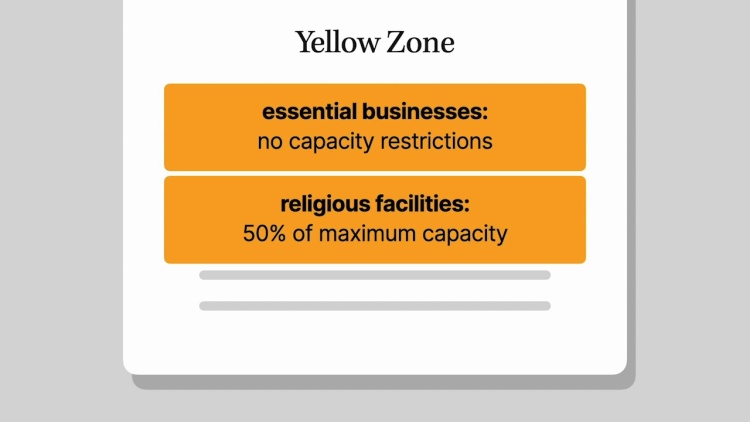Roman Catholic Diocese of Brooklyn, New York v. Andrew M. Cuomo, Governor of New York
United States Supreme Court
141 S. Ct. 63, 592 U.S. 14 (2020)
- Written by Haley Gintis, JD
Facts
In response to the COVID-19 pandemic, New York Governor Andrew M. Cuomo (defendant) issued an executive order restricting the allowed capacity in certain facilities. The executive order categorized areas into color-coded zones. Facilities deemed as essential within orange and red zones, which included acupuncture facilities, campgrounds, and garages, had no restrictions on capacity. However, religious facilities in orange and red zones were restricted to limiting religious services to 25 and 10 individuals, respectively. The executive order completely halted the operations of other nonessential businesses. The Roman Catholic Diocese of Brooklyn and the Agudath Israel of America (collectively, the religious institutions) (plaintiffs) filed an action in federal court against Cuomo for violating their First Amendment right to the free exercise of religion. The religious institutions claimed that Cuomo had intentionally drawn the boundaries of the zones to restrict the capacities of places of worship. Additionally, the religious institutions provided evidence that they had voluntarily restricted their capacities and had no COVID-19 outbreaks among their congregations. Following the filing of the case, the executive order was revised, and the religious institutions were permitted to hold services at 50 percent of usual capacity. While the case was pending, the religious institutions moved for an emergency preliminary injunction against the executive order. The district court denied the motion. The matter was appealed. The appellate court denied the emergency injunction. The matter was appealed to the United States Supreme Court.
Rule of Law
Issue
Holding and Reasoning (Per curiam)
Concurrence (Gorsuch, J.)
Concurrence (Kavanaugh, J.)
Dissent (Roberts, C.J.)
Dissent (Breyer, J.)
Dissent (Sotomayor, J.)
What to do next…
Here's why 899,000 law students have relied on our case briefs:
- Written by law professors and practitioners, not other law students. 47,000 briefs, keyed to 994 casebooks. Top-notch customer support.
- The right amount of information, includes the facts, issues, rule of law, holding and reasoning, and any concurrences and dissents.
- Access in your classes, works on your mobile and tablet. Massive library of related video lessons and high quality multiple-choice questions.
- Easy to use, uniform format for every case brief. Written in plain English, not in legalese. Our briefs summarize and simplify; they don’t just repeat the court’s language.





